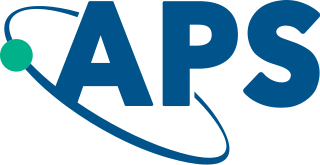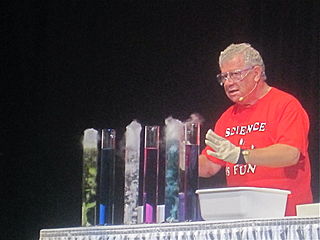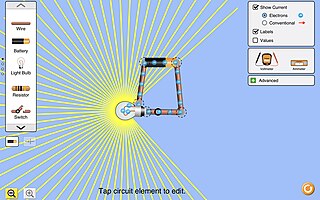A teaching method is a set of principles and methods used by teachers to enable student learning. These strategies are determined partly by the subject matter to be taught, partly by the relative expertise of the learners, and partly by constraints caused by the learning environment. For a particular teaching method to be appropriate and efficient it has to take into account the learner, the nature of the subject matter, and the type of learning it is supposed to bring about.

The American Physical Society (APS) is a not-for-profit membership organization of professionals in physics and related disciplines, comprising nearly fifty divisions, sections, and other units. Its mission is the advancement and diffusion of knowledge of physics. It publishes more than a dozen scientific journals, including the prestigious Physical Review and Physical Review Letters, and organizes more than twenty science meetings each year. It is a member society of the American Institute of Physics. Since January 2021, it is led by chief executive officer Jonathan Bagger.
The Institute of Physics (IOP) is a UK-based not-for-profit learned society and professional body that works to advance physics education, research and application.

David Orlin Hestenes is a theoretical physicist and science educator. He is best known as chief architect of geometric algebra as a unified language for mathematics and physics, and as founder of Modelling Instruction, a research-based program to reform K–12 Science, Technology, Engineering, and Mathematics (STEM) education.
Physics education or physics teaching refers to the education methods currently used to teach physics. The occupation is called physics educator or physics teacher. Physics education research refers to an area of pedagogical research that seeks to improve those methods. Historically, physics has been taught at the high school and college level primarily by the lecture method together with laboratory exercises aimed at verifying concepts taught in the lectures. These concepts are better understood when lectures are accompanied with demonstration, hand-on experiments, and questions that require students to ponder what will happen in an experiment and why. Students who participate in active learning for example with hands-on experiments learn through self-discovery. By trial and error they learn to change their preconceptions about phenomena in physics and discover the underlying concepts. Physics education is part of the broader area of science education.
The American Journal of Physics is a monthly, peer-reviewed scientific journal published by the American Association of Physics Teachers and the American Institute of Physics. The editor-in-chief is Beth Parks of Colgate University.

The Academy of Legal Studies in Business is an American-based professional association for teachers and scholars in the fields of business, law, legal environment, and law-related courses outside of professional law schools. It was founded in 1924, and now has an international membership. The nearly 1,000 members teach primarily in schools of business in colleges and universities, at both the undergraduate and graduate levels. Members come from all fifty states, Canada, Australia, New Zealand, Ireland, England, and a number of other nations.
Canadian Association of Physicists (CAP), or in French Association canadienne des physiciens et physiciennes (ACP) is a Canadian professional society that focuses on creating awareness among Canadians and Canadian legislators of physics issues, sponsoring physics related events, physics outreach, and publishes Physics in Canada. It was founded in July 1945. The organization has over 1,600 members and is bilingual, functioning in English and French.
Chiropractic education trains students in chiropractic. The entry criteria, structure, teaching methodology and nature of chiropractic programs offered at chiropractic schools vary considerably around the world. Accredited Doctor of Chiropractic programs include instruction in several academic areas including neurology, radiology, microbiology, psychology, ethics, biology, gross anatomy, biochemistry, spinal anatomy and more. Prospective students are also usually trained in clinical nutrition, public health, pediatrics and other health or wellness related areas.
The American Association of Physics Teachers (AAPT) was founded in 1930 for the purpose of "dissemination of knowledge of physics, particularly by way of teaching." There are more than 10,000 members in over 30 countries. AAPT publications include two peer-reviewed journals, the American Journal of Physics and The Physics Teacher. The association has two annual National Meetings and has regional sections with their own meetings and organization. The association also offers grants and awards for physics educators, including the Richtmyer Memorial Award and programs and contests for physics educators and students. It is headquartered at the American Center for Physics in College Park, Maryland.
Thomas Luna is an American politician who served as Idaho superintendent of public instruction from 2006 to 2014. Luna was the chair of Idaho Republican Party from June 2020 to July 2022.

The Fanny Edel Falk Laboratory School, or simply the Falk School, is a private kindergarten through eighth grade laboratory school of the University of Pittsburgh. It is located on the University of Pittsburgh's upper campus on Allequippa St.
The International Forum of Public Universities (IFPU) [French: Forum international des universités publiques (FIUP)] is a consortium of 23 public universities.
Syracuse University Project Advance (SUPA) is an educational program that provides high school students with the opportunity to take Syracuse University courses in their own schools during the regularly scheduled school day. After successful completion of the course(s) they can request to transfer the credits they earn into the colleges/universities they attend after high school. This is an example of a Concurrent Enrollment Program or Partnership (CEP).

Bassam Z. Shakhashiri is a professor of chemistry at the University of Wisconsin-Madison, where he is the holder of the William T. Evjue Distinguished Chair. An active advocate for science education, he is the author of multiple books of chemical demonstrations. He was the 2012 president of the American Chemical Society and has received numerous awards and honors.

Race to the Top was a $4.35 billion United States Department of Education competitive grant created to spur and reward innovation and reforms in state and local district K–12 education. Funded as part of the American Recovery and Reinvestment Act of 2009, it was announced by President Barack Obama and Secretary of Education Arne Duncan on July 24, 2009. States competing for the grants were awarded points for enacting certain educational policies, instituting performance-based evaluations for teachers and principals based on multiple measures of educator effectiveness, adopting common standards, adopting policies that did not prohibit the expansion of high-quality charter schools, turning around the lowest-performing schools, and building and using data systems.
Horace Richard Crane was an American physicist, the inventor of the Race Track Synchrotron, a recipient of President Ronald Reagan's National Medal of Science "for the first measurement of the magnetic moment and spin of free electrons and positrons". He was also noted for proving the existence of neutrinos. The National Academy of Sciences called Crane "an extraordinary physicist". The University of Michigan called him "one of the most distinguished experimental physicists of the 20th century". Crane was a chairman of the Department of Physics and a professor of physics at the University of Michigan, a member of the National Academy of Sciences.

PhET Interactive Simulations, a project at the University of Colorado Boulder, is a non-profit open educational resource project that creates and hosts explorable explanations. It was founded in 2002 by Nobel Laureate Carl Wieman. PhET began with Wieman's vision to improve the way science is taught and learned. Their stated mission is "To advance science and math literacy and education worldwide through free interactive simulations."
Ruth Wright Chabay is an American physics educator known for her work in educational technology and as the coauthor of the calculus-based physics textbook Matter and Interactions. She is professor emerita of physics at North Carolina State University.






